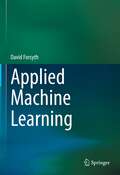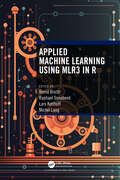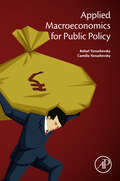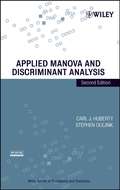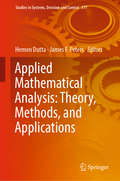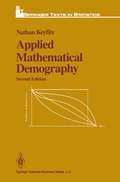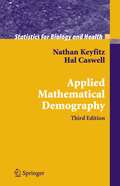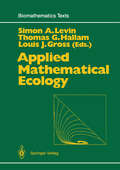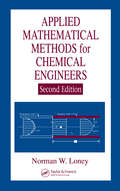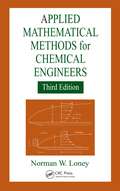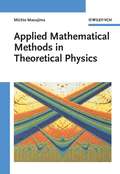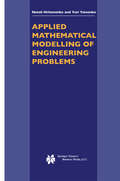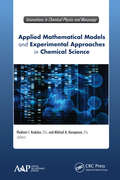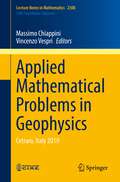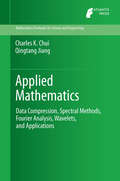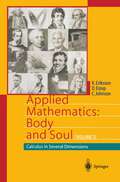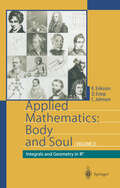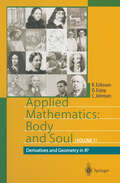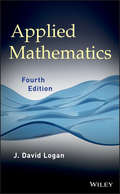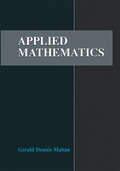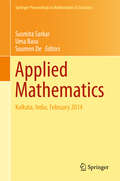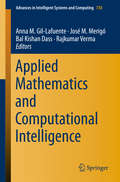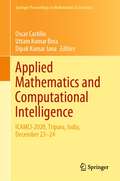- Table View
- List View
Applied Machine Learning
by David ForsythMachine learning methods are now an important tool for scientists, researchers, engineers and students in a wide range of areas. This book is written for people who want to adopt and use the main tools of machine learning, but aren’t necessarily going to want to be machine learning researchers. Intended for students in final year undergraduate or first year graduate computer science programs in machine learning, this textbook is a machine learning toolkit. Applied Machine Learning covers many topics for people who want to use machine learning processes to get things done, with a strong emphasis on using existing tools and packages, rather than writing one’s own code.A companion to the author's Probability and Statistics for Computer Science, this book picks up where the earlier book left off (but also supplies a summary of probability that the reader can use).Emphasizing the usefulness of standard machinery from applied statistics, this textbook gives an overview of the major applied areas in learning, including coverage of:• classification using standard machinery (naive bayes; nearest neighbor; SVM)• clustering and vector quantization (largely as in PSCS)• PCA (largely as in PSCS)• variants of PCA (NIPALS; latent semantic analysis; canonical correlation analysis)• linear regression (largely as in PSCS)• generalized linear models including logistic regression• model selection with Lasso, elasticnet• robustness and m-estimators• Markov chains and HMM’s (largely as in PSCS)• EM in fairly gory detail; long experience teaching this suggests one detailed example is required, which students hate; but once they’ve been through that, the next one is easy• simple graphical models (in the variational inference section)• classification with neural networks, with a particular emphasis onimage classification• autoencoding with neural networks• structure learning
Applied Machine Learning Using mlr3 in R
by Bernd Bischl Raphael Sonabend Lars Kotthoff Michel Langmlr3 is an award-winning ecosystem of R packages that have been developed to enable state-of-the-art machine learning capabilities in R. Applied Machine Learning Using mlr3 in R gives an overview of flexible and robust machine learning methods, with an emphasis on how to implement them using mlr3 in R. It covers various key topics, including basic machine learning tasks, such as building and evaluating a predictive model; hyperparameter tuning of machine learning approaches to obtain peak performance; building machine learning pipelines that perform complex operations such as pre-processing followed by modelling followed by aggregation of predictions; and extending the mlr3 ecosystem with custom learners, measures, or pipeline components. Features: In-depth coverage of the mlr3 ecosystem for users and developers Explanation and illustration of basic and advanced machine learning concepts Ready to use code samples that can be adapted by the user for their application Convenient and expressive machine learning pipelining enabling advanced modelling Coverage of topics that are often ignored in other machine learning books The book is primarily aimed at researchers, practitioners, and graduate students who use machine learning or who are interested in using it. It can be used as a textbook for an introductory or advanced machine learning class that uses R, as a reference for people who work with machine learning methods, and in industry for exploratory experiments in machine learning.
Applied Machine Learning Using mlr3 in R
by Bernd Bischl Raphael Sonabend Lars Kotthoff Michel Langmlr3 is an award-winning ecosystem of R packages that have been developed to enable state-of-the-art machine learning capabilities in R. Applied Machine Learning Using mlr3 in R gives an overview of flexible and robust machine learning methods, with an emphasis on how to implement them using mlr3 in R. It covers various key topics, including basic machine learning tasks, such as building and evaluating a predictive model; hyperparameter tuning of machine learning approaches to obtain peak performance; building machine learning pipelines that perform complex operations such as pre-processing followed by modelling followed by aggregation of predictions; and extending the mlr3 ecosystem with custom learners, measures, or pipeline components. Features: In-depth coverage of the mlr3 ecosystem for users and developers Explanation and illustration of basic and advanced machine learning concepts Ready to use code samples that can be adapted by the user for their application Convenient and expressive machine learning pipelining enabling advanced modelling Coverage of topics that are often ignored in other machine learning books The book is primarily aimed at researchers, practitioners, and graduate students who use machine learning or who are interested in using it. It can be used as a textbook for an introductory or advanced machine learning class that uses R, as a reference for people who work with machine learning methods, and in industry for exploratory experiments in machine learning.
Applied Macroeconomics for Public Policy
by Rafael Yanushevsky Camilla YanushevskyApplied Macroeconomics for Public Policy applies system and control theory approaches to macroeconomic problems. The book shows how to build simple and efficient macroeconomic models for policy analysis. By using these models, instead of complex multi-criteria models with uncertain parameters, readers will gain new certainty in macroeconomic decision-making. As high debt to GDP ratios cause problems in societies, this book provides insights on improving economies during and after economic downturns.Provides a detailed analysis of existing macroeconomic modelsAddresses the dynamics of debt to GDP ratio and the effects of fiscal and monetary policy on this ratioShows how to use models to evaluate the dynamics of the debt to GDP ratio in cases of government spending and tax cuts and to decide whether such economic measures are efficientUses optimal theory to obtain optimal yearly debt levels to reach the established goals (decrease debt or balance budget) Provides many examples and software exercises to promote learning by doing
Applied MANOVA and Discriminant Analysis (Wiley Series in Probability and Statistics #498)
by Carl J. Huberty Stephen OlejnikA complete introduction to discriminant analysis--extensively revised, expanded, and updated This Second Edition of the classic book, Applied Discriminant Analysis, reflects and references current usage with its new title, Applied MANOVA and Discriminant Analysis. Thoroughly updated and revised, this book continues to be essential for any researcher or student needing to learn to speak, read, and write about discriminant analysis as well as develop a philosophy of empirical research and data analysis. Its thorough introduction to the application of discriminant analysis is unparalleled. Offering the most up-to-date computer applications, references, terms, and real-life research examples, the Second Edition also includes new discussions of MANOVA, descriptive discriminant analysis, and predictive discriminant analysis. Newer SAS macros are included, and graphical software with data sets and programs are provided on the book's related Web site. The book features: Detailed discussions of multivariate analysis of variance and covariance An increased number of chapter exercises along with selected answers Analyses of data obtained via a repeated measures design A new chapter on analyses related to predictive discriminant analysis Basic SPSS(r) and SAS(r) computer syntax and output integrated throughout the book Applied MANOVA and Discriminant Analysis enables the reader to become aware of various types of research questions using MANOVA and discriminant analysis; to learn the meaning of this field's concepts and terms; and to be able to design a study that uses discriminant analysis through topics such as one-factor MANOVA/DDA, assessing and describing MANOVA effects, and deleting and ordering variables.
Applied Mathematical Analysis: Theory, Methods, and Applications (Studies in Systems, Decision and Control #177)
by Hemen Dutta James F. PetersThis book addresses key aspects of recent developments in applied mathematical analysis and its use. It also highlights a broad range of applications from science, engineering, technology and social perspectives. Each chapter investigates selected research problems and presents a balanced mix of theory, methods and applications for the chosen topics. Special emphasis is placed on presenting basic developments in applied mathematical analysis, and on highlighting the latest advances in this research area. The book is presented in a self-contained manner as far as possible, and includes sufficient references to allow the interested reader to pursue further research in this still-developing field. The primary audience for this book includes graduate students, researchers and educators; however, it will also be useful for general readers with an interest in recent developments in applied mathematical analysis and applications.
Applied Mathematical Demography (Springer Texts in Statistics)
by Nathan KeyfitzWhat follows is a new edition of the second in a series of three books providing an account of the mathematical development of demography. The first, Introduction to the Mathematics of Population (Addison-Wesley, 1968), gave the mathematical background. The second, the original of the present volume, was concerned with demography itself. The third in the sequence, Mathematics Through Problems (with John Beekman; Springer Verlag, 1982), supplemented the first two with an ordered sequence of problems and answers. Readers interested in the mathematics may consult the earlier book, republished with revisions by Addison-Wesley in 1977 and still in print. There is no overlap in subject matter between Applied Mathematical Demography and the Introduction to the Mathematics of Population. Three new chapters have been added, dealing with matters that have come recently into the demographic limelight: multi-state calculations, family demogra phy, and heterogeneity. vii PREFACE This book is concerned with commonsense questions about, for instance, the effect of a lowered death rate on the proportion of old people or the effect of abortions on the birth rate. The answers that it reaches are not always commonsense, and we will meet instances in which intuition has to be adjusted to accord with what the mathematics shows to be the case.
Applied Mathematical Ecology (Biomathematics #18)
The Second Autumn Course on Mathematical Ecology was held at the Intern ational Centre for Theoretical Physics in Trieste, Italy in November and December of 1986. During the four year period that had elapsed since the First Autumn Course on Mathematical Ecology, sufficient progress had been made in applied mathemat ical ecology to merit tilting the balance maintained between theoretical aspects and applications in the 1982 Course toward applications. The course format, while similar to that of the first Autumn Course on Mathematical Ecology, consequently focused upon applications of mathematical ecology. Current areas of application are almost as diverse as the spectrum covered by ecology. The topiys of this book reflect this diversity and were chosen because of perceived interest and utility to developing countries. Topical lectures began with foundational material mostly derived from Math ematical Ecology: An Introduction (a compilation of the lectures of the 1982 course published by Springer-Verlag in this series, Volume 17) and, when possible, progressed to the frontiers of research. In addition to the course lectures, workshops were arranged for small groups to supplement and enhance the learning experience. Other perspectives were provided through presentations by course participants and speakers at the associated Research Conference. Many of the research papers are in a companion volume, Mathematical Ecology: Proceedings Trieste 1986, published by World Scientific Press in 1988. This book is structured primarily by application area. Part II provides an introduction to mathematical and statistical applications in resource management.
Applied Mathematical Methods for Chemical Engineers
by Norman W. LoneyFocusing on the application of mathematics to chemical engineering, Applied Mathematical Methods for Chemical Engineers, Second Edition addresses the setup and verification of mathematical models using experimental or other independently derived data. An expanded and updated version of its well-respected predecessor, this book uses worked
Applied Mathematical Methods for Chemical Engineers
by Norman W. LoneyFocusing on the application of mathematics to chemical engineering, Applied Mathematical Methods for Chemical Engineers addresses the setup and verification of mathematical models using experimental or other independently derived data. The book provides an introduction to differential equations common to chemical engineering, followed by examples o
Applied Mathematical Methods in Theoretical Physics
by Michio MasujimaAll there is to know about functional analysis, integral equations and calculus of variations in a single volume. This advanced textbook is divided into two parts: The first on integral equations and the second on the calculus of variations. It begins with a short introduction to functional analysis, including a short review of complex analysis, before continuing a systematic discussion of different types of equations, such as Volterra integral equations, singular integral equations of Cauchy type, integral equations of the Fredholm type, with a special emphasis on Wiener-Hopf integral equations and Wiener-Hopf sum equations. After a few remarks on the historical development, the second part starts with an introduction to the calculus of variations and the relationship between integral equations and applications of the calculus of variations. It further covers applications of the calculus of variations developed in the second half of the 20th century in the fields of quantum mechanics, quantum statistical mechanics and quantum field theory. Throughout the book, the author presents over 150 problems and exercises - many from such branches of physics as quantum mechanics, quantum statistical mechanics, and quantum field theory - together with outlines of the solutions in each case. Detailed solutions are given, supplementing the materials discussed in the main text, allowing problems to be solved making direct use of the method illustrated. The original references are given for difficult problems. The result is complete coverage of the mathematical tools and techniques used by physicists and applied mathematicians Intended for senior undergraduates and first-year graduates in science and engineering, this is equally useful as a reference and self-study guide.
Applied Mathematical Modelling of Engineering Problems (Applied Optimization #81)
by N.V. Hritonenko Yuri P. YatsenkoThe subject of the book is the "know-how" of applied mathematical modelling: how to construct specific models and adjust them to a new engineering environment or more precise realistic assumptions; how to analyze models for the purpose of investigating real life phenomena; and how the models can extend our knowledge about a specific engineering process. Two major sources of the book are the stock of classic models and the authors' wide experience in the field. The book provides a theoretical background to guide the development of practical models and their investigation. It considers general modelling techniques, explains basic underlying physical laws and shows how to transform them into a set of mathematical equations. The emphasis is placed on common features of the modelling process in various applications as well as on complications and generalizations of models. The book covers a variety of applications: mechanical, acoustical, physical and electrical, water transportation and contamination processes; bioengineering and population control; production systems and technical equipment renovation. Mathematical tools include partial and ordinary differential equations, difference and integral equations, the calculus of variations, optimal control, bifurcation methods, and related subjects.
Applied Mathematical Models and Experimental Approaches in Chemical Science (Innovations in Chemical Physics and Mesoscopy)
by Vladimir I. Kodolov DSc Mikhail A. KorepanovThis new book focuses on nanomaterial development as well as investigations of combustion and explosion processes. It presents valuable information on the modeling of processes and on quantum chemical calculations and leading-edge research from around the world in this dynamic field, focusing on concepts above formal experimental techniques and theoretical methods of chemical physics for micro- and nanotechnologies. Also presented are non-linear kinetic appearances and their possible applications.
Applied Mathematical Models and Experimental Approaches in Chemical Science (Innovations in Chemical Physics and Mesoscopy)
by Vladimir Ivanovitch Kodolov Mikhail A. KorepanovThis new book focuses on nanomaterial development as well as investigations of combustion and explosion processes. It presents valuable information on the modeling of processes and on quantum chemical calculations and leading-edge research from around the world in this dynamic field, focusing on concepts above formal experimental techniques and theoretical methods of chemical physics for micro- and nanotechnologies. Also presented are non-linear kinetic appearances and their possible applications.
Applied Mathematical Problems in Geophysics: Cetraro, Italy 2019 (Lecture Notes in Mathematics #2308)
by Massimo Chiappini Vincenzo VespriThis CIME Series book provides mathematical and simulation tools to help resolve environmental hazard and security-related issues.The contributions reflect five major topics identified by the SIES (Strategic Initiatives for the Environment and Security) as having significant societal impact: optimal control in waste management, in particular the degradation of organic waste by an aerobic biomass, by means of a mathematical model; recent developments in the mathematical analysis of subwave resonators; conservation laws in continuum mechanics, including an elaboration on the notion of weak solutions and issues related to entropy criteria; the applications of variational methods to 1-dimensional boundary value problems, in particular to light ray-tracing in ionospheric physics; and the mathematical modelling of potential electromagnetic co-seismic events associated to large earthquakes.This material will provide a sound foundation for those who intend to approach similar problems from a multidisciplinary perspective.
Applied Mathematics: Data Compression, Spectral Methods, Fourier Analysis, Wavelets, and Applications (Mathematics Textbooks for Science and Engineering #2)
by Charles K. Chui Qingtang JiangThis textbook, apart from introducing the basic aspects of applied mathematics, focuses on recent topics such as information data manipulation, information coding, data approximation, data dimensionality reduction, data compression, time-frequency and time scale bases, image manipulation, and image noise removal. The methods treated in more detail include spectral representation and “frequency” of the data, providing valuable information for, e.g. data compression and noise removal. Furthermore, a special emphasis is also put on the concept of “wavelets” in connection with the “multi-scale” structure of data-sets. The presentation of the book is elementary and easily accessible, requiring only some knowledge of elementary linear algebra and calculus. All important concepts are illustrated with examples, and each section contains between 10 an 25 exercises. A teaching guide, depending on the level and discipline of instructions is included for classroom teaching and self-study.
Applied Mathematics: Calculus in Several Dimensions
by Kenneth Eriksson Donald Estep Claes JohnsonApplied Mathematics: Body & Soul is a mathematics education reform project developed at Chalmers University of Technology and includes a series of volumes and software. The program is motivated by the computer revolution opening new possibilitites of computational mathematical modeling in mathematics, science and engineering. It consists of a synthesis of Mathematical Analysis (Soul), Numerical Computation (Body) and Application. Volumes I-III present a modern version of Calculus and Linear Algebra, including constructive/numerical techniques and applications intended for undergraduate programs in engineering and science. Further volumes present topics such as Dynamical Systems, Fluid Dynamics, Solid Mechanics and Electro-Magnetics on an advanced undergraduate/graduate level. The authors are leading researchers in Computational Mathematics who have written various successful books.
Applied Mathematics: Volume 2: Integrals and Geometry in IRn
by Kenneth Eriksson Donald Estep Claes JohnsonApplied Mathematics: Body & Soul is a mathematics education reform project developed at Chalmers University of Technology and includes a series of volumes and software. The program is motivated by the computer revolution opening new possibilities of computational mathematical modeling in mathematics, science and engineering. It consists of a synthesis of Mathematical Analysis (Soul), Numerical Computation (Body) and Application. Volumes I-III present a modern version of Calculus and Linear Algebra, including constructive/numerical techniques and applications intended for undergraduate programs in engineering and science. Further volumes present topics such as Dynamical Systems, Fluid Dynamics, Solid Mechanics and Electro-Magnetics on an advanced undergraduate/graduate level. The authors are leading researchers in Computational Mathematics who have written various successful books.
Applied Mathematics: Volume 1: Derivatives and Geometry in IR3
by Kenneth Eriksson Donald Estep Claes JohnsonApplied Mathematics: Body & Soul is a mathematics education reform project developed at Chalmers University of Technology and includes a series of volumes and software. The program is motivated by the computer revolution opening new possibilitites of computational mathematical modeling in mathematics, science and engineering. It consists of a synthesis of Mathematical Analysis (Soul), Numerical Computation (Body) and Application. Volumes I-III present a modern version of Calculus and Linear Algebra, including constructive/numerical techniques and applications intended for undergraduate programs in engineering and science. Further volumes present topics such as Dynamical Systems, Fluid Dynamics, Solid Mechanics and Electro-Magnetics on an advanced undergraduate/graduate level. The authors are leading researchers in Computational Mathematics who have written various successful books.
Applied Mathematics (Undergraduate Texts in Mathematics)
by J. David LoganPraise for the Third Edition “Future mathematicians, scientists, and engineers should find the book to be an excellent introductory text for coursework or self-study as well as worth its shelf space for reference.” —MAA Reviews Applied Mathematics, Fourth Edition is a thoroughly updated and revised edition on the applications of modeling and analyzing natural, social, and technological processes. The book covers a wide range of key topics in mathematical methods and modeling and highlights the connections between mathematics and the applied and natural sciences. The Fourth Edition covers both standard and modern topics, including scaling and dimensional analysis; regular and singular perturbation; calculus of variations; Green’s functions and integral equations; nonlinear wave propagation; and stability and bifurcation. The book provides extended coverage of mathematical biology, including biochemical kinetics, epidemiology, viral dynamics, and parasitic disease. In addition, the new edition features: Expanded coverage on orthogonality, boundary value problems, and distributions, all of which are motivated by solvability and eigenvalue problems in elementary linear algebra Additional MATLAB® applications for computer algebra system calculations Over 300 exercises and 100 illustrations that demonstrate important concepts New examples of dimensional analysis and scaling along with new tables of dimensions and units for easy reference Review material, theory, and examples of ordinary differential equations New material on applications to quantum mechanics, chemical kinetics, and modeling diseases and viruses Written at an accessible level for readers in a wide range of scientific fields, Applied Mathematics, Fourth Edition is an ideal text for introducing modern and advanced techniques of applied mathematics to upper-undergraduate and graduate-level students in mathematics, science, and engineering. The book is also a valuable reference for engineers and scientists in government and industry.
Applied Mathematics
by Gerald D. MahanThis volume is a textbook for a year-long graduate level course in All research universities have applied mathematics for scientists and engineers. such a course, which could be taught in different departments, such as mathematics, physics, or engineering. I volunteered to teach this course when I realized that my own research students did not learn much in this course at my university. Then I learned that the available textbooks were too introduc tory. While teaching this course without an assigned text, I wrote up my lecture notes and gave them to the students. This textbook is a result of that endeavor. When I took this course many, many, years ago, the primary references were the two volumes of P. M. Morse and H. Feshbach, Methods of Theoretical Physics (McGraw-Hill, 1953). The present text returns the contents to a similar level, although the syllabus is quite different than given in this venerable pair of books.
Applied Mathematics: Kolkata, India, February 2014 (Springer Proceedings in Mathematics & Statistics #146)
by Susmita Sarkar Uma Basu Soumen DeThe book is based on research presentations at the international conference, “Emerging Trends in Applied Mathematics: In the Memory of Sir Asutosh Mookerjee, S.N. Bose, M.N. Saha and N.R. Sen”, held at the Department of Applied Mathematics, University of Calcutta, during 12–14 February 2014. It focuses on various emerging and challenging topics in the field of applied mathematics and theoretical physics. The book will be a valuable resource for postgraduate students at higher levels and researchers in applied mathematics and theoretical physics.Researchers presented a wide variety of themes in applied mathematics and theoretical physics—such as emergent periodicity in a field of chaos; Ricci flow equation and Poincare conjecture; Bose–Einstein condensation; geometry of local scale invariance and turbulence; statistical mechanics of human resource allocation: mathematical modelling of job-matching in labour markets; contact problem in elasticity; the Saha equation; computational fluid dynamics with applications in aerospace problems; an introduction to data assimilation, stochastic analysis and bounds on noise for Holling type-II model, graph theoretical invariants of chemical and biological systems; strongly correlated phases and quantum phase transitions of ultra cold bosons; and the mathematical modelling of breast cancer treatment.
Applied Mathematics and Computational Intelligence (Advances in Intelligent Systems and Computing #730)
by Anna M. Gil-Lafuente José M. Merigó Bal Kishan Dass Rajkumar VermaThis book gathers selected papers presented at the conference of the Forum for Interdisciplinary Mathematics (FIM), held at Palau Macaya, Barcelona, on 18 to 20 November, 2015. The event was co-organized by the University of Barcelona (Spain), the Spanish Royal Academy of Economic and Financial Sciences (Spain) and the Forum for Interdisciplinary Mathematics (India). This instalment of the conference was presented with the title “Applied Mathematics and Computational Intelligence” and particularly focused on the use of Mathematics and Computational Intelligence techniques in a diverse range of scientific disciplines, as well as their applications in real-world problems. The book presents thirty peer-reviewed research papers, organised into four topical sections: on Mathematical Foundations; Computational Intelligence and Optimization Techniques; Modelling and Simulation Techniques; and Applications in Business and Engineering. This book will be of great interest to anyone working in the area of applied mathematics and computational intelligence and will be especially useful for scientists and graduate students pursuing research in these fields.
Applied Mathematics and Computational Intelligence: ICAMCI-2020, Tripura, India, December 23–24 (Springer Proceedings in Mathematics & Statistics #413)
by Oscar Castillo Uttam Kumar Bera Dipak Kumar JanaThis book contains select papers presented at the International Conference on Applied Mathematics and Computational Intelligence (ICAMCI-2020), held at the National Institute of Technology Agartala, Tripura, India, from 19–20 March 2020. It discusses the most recent breakthroughs in intelligent techniques such as fuzzy logic, neural networks, optimization algorithms, and their application in the development of intelligent information systems by using applied mathematics. The book also explains how these systems will be used in domains such as intelligent control and robotics, pattern recognition, medical diagnosis, time series prediction, and complicated problems in optimization. The book publishes new developments and advances in various areas of type-3 fuzzy, intuitionistic fuzzy, computational mathematics, block chain, creak analysis, supply chain, soft computing, fuzzy systems, hybrid intelligent systems, thermos-elasticity, etc. The book is targeted to researchers, scientists, professors, and students of mathematics, computer science, applied science and engineering, interested in the theory and applications of intelligent systems in real-world applications. It provides young researchers and students with new directions for their future study by exchanging fresh thoughts and finding new problems.
